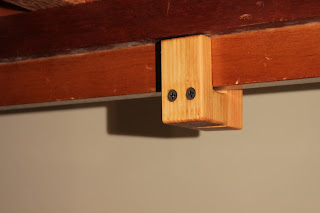Friday, April 29, 2016
Chopsticks
Saturday, April 9, 2016
Fir Escutcheon Plates, Shelf
A bit more complicated to make than they look! The OD was turned concentrically with the ID on the lathe. They are made this way to fit over existing pipes coming out of the wall.
Got lucky on the above two; the grain lines up through the seam.
Below is a shelf I made which attaches to the side of a bed, to avoid putting screws in the walls.
There's a rabbet (if you will) on the post to keep the shear force off the screws, though it really shouldn't matter. The bedframe is the weakest link. Below is the bottom clamp.
Wednesday, April 6, 2016
HDPE Recyling, Shear Sheath
HDPE plastic, commonly used for containers, is not too hard to recycle at home. There are many instructions on the internet about how to do it. The results are usually pretty mediocre though, as HDPE in its melted state is a thick rubbery mass with bubbles inside (the same could be said about the contents of my head?). It's a nice plastic though; it's food safe and machines without fumes unlike POM or acrylic.
The best method I've found yet does not eliminate bubbles, but it produces a very usable and uniform cylinder of plastic:
-Cut top off of aluminum can
-Cut apart containers and clean well with soap
-Cut plastic containers into pieces which can fit into the can
-Put can(s) into toaster oven at 350 deg. F/175 deg. C
-Add plastic flakes to can
-Continue to add flakes and tamp goo until can is full
-Remove can from oven and quickly compress with fitted piston and clamp:
-Leave compressed till cool
This is the piston and can support, which I turned on the lathe. The piston is just about air-tight with the cans, though it probably doesn't need to be.
The HDPE doesn't stick to the can or the wood once it cools. The cylinder I made has been turned back to shavings in lathe experiments, but I will post a photo when I make another.
I also made a leather sheath:
Simple sheath for simple shears. Made of leather: skived, saddle stitched, burnished, and oiled.
The best method I've found yet does not eliminate bubbles, but it produces a very usable and uniform cylinder of plastic:
-Cut top off of aluminum can
-Cut apart containers and clean well with soap
-Cut plastic containers into pieces which can fit into the can
-Put can(s) into toaster oven at 350 deg. F/175 deg. C
-Add plastic flakes to can
-Continue to add flakes and tamp goo until can is full
-Remove can from oven and quickly compress with fitted piston and clamp:
-Leave compressed till cool
This is the piston and can support, which I turned on the lathe. The piston is just about air-tight with the cans, though it probably doesn't need to be.
The HDPE doesn't stick to the can or the wood once it cools. The cylinder I made has been turned back to shavings in lathe experiments, but I will post a photo when I make another.
I also made a leather sheath:
Simple sheath for simple shears. Made of leather: skived, saddle stitched, burnished, and oiled.
Trailer Repair, Knife Repair
The poorly attached back door fell off this trailer, so I built it a new one.
You will notice a 'weight relief' hole in the above two photos. This was found to be the most aerodynamically stable of all options, and was carefully planned and implemented. ;)
The rubber grip on my craft knife was getting tired, so I tied a new one of waxed linen. I don't know how long it will last, but it looks neat for now. It's a nine-strand turk's head.
Subscribe to:
Comments (Atom)






















